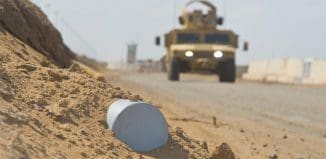A new method to detect RDX
This post is also available in:  עברית (Hebrew)
עברית (Hebrew)
 A chemical which is often the key ingredient in improvised explosive devices (IEDs) can be quickly and safely detected in trace amounts by a new polymer created by a team of Cornell University chemists.
A chemical which is often the key ingredient in improvised explosive devices (IEDs) can be quickly and safely detected in trace amounts by a new polymer created by a team of Cornell University chemists.
The polymer, which potentially could be used in low-cost, handheld explosive detectors and could supplement or replace bomb-sniffing dogs, was invented in the lab of William Dichtel, assistant professor of chemistry and chemical biology. The work was published online in May in the Journal of the American Chemical Society.
A Cornell University release reports that RDX, short for research department explosive, is an explosive material common in military and industrial applications that is also a favorite of bomb-making terrorists. It requires a detonator to explode, but when detonated, it is more powerful than TNT. What is more, RDX’s vapor pressure is 1,000 times lower than TNT’s, making it almost impossible to detect without direct contact with a concentrator, like the swabs used at airport security.
i-HLS ISRAEL Homeland Security
According to HLS NewsWire Dichtel and graduate student Deepti Gopalakrishnan made a polymer that uses fluorescence quickly and accurately to ascertain whether RDX is present on a surface or in the air.
“One of the goals is to make detectors that can detect not just explosives on someone’s hands, but in the cloud around them,” Dichtel said — much like the dust cloud surrounding Charlie Brown’s friend Pigpen, he said. “If someone had an IED in their bag, it would be nice to not have to open it.”





























